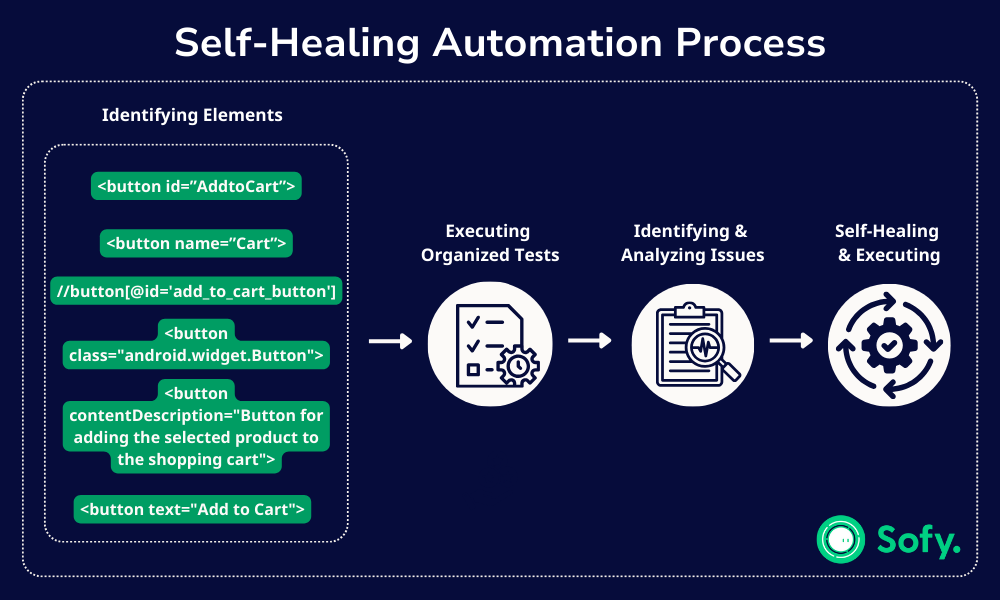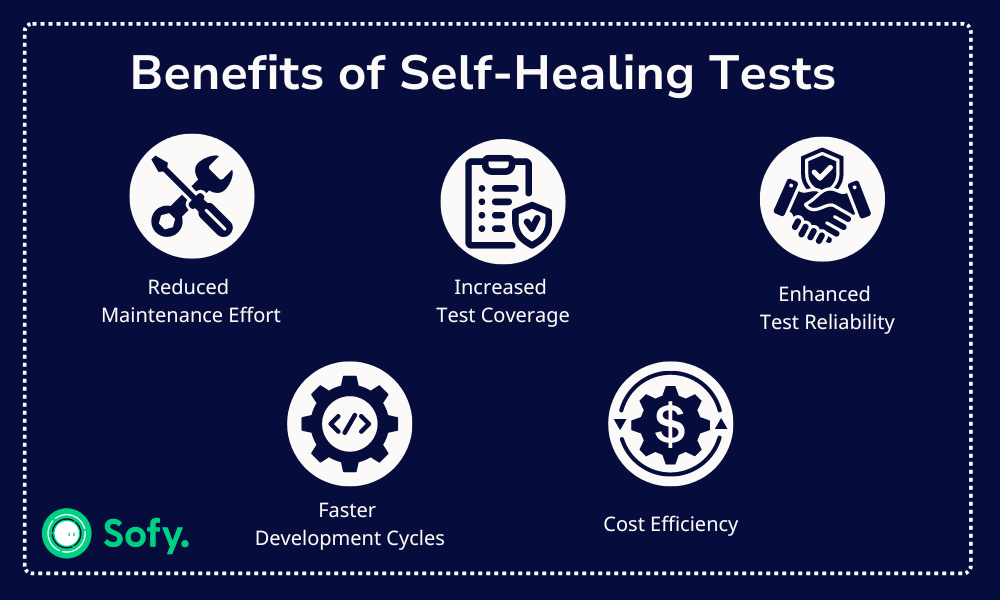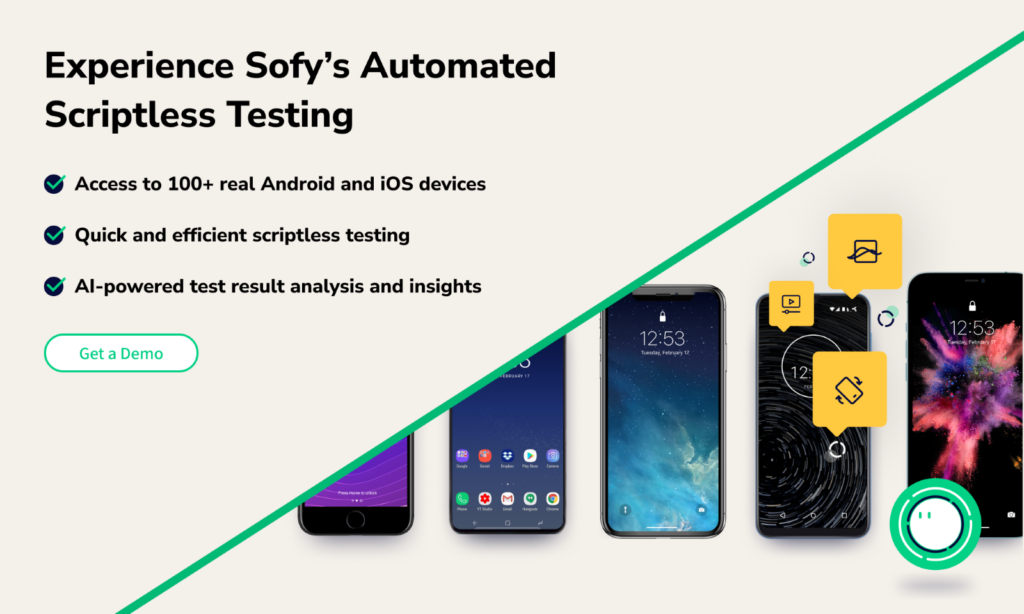Ensuring the reliability and functionality of mobile applications across various devices and operating systems is crucial for modern app development. Traditional automated testing methods, while effective, often struggle to keep up with the dynamic nature of mobile apps. This is where self-healing automated tests come into play.
In this blog, we’ll delve into self-healing automated tests, how they work, examples in action, their benefits, and how Sofy’s self-healing capabilities streamline your mobile app testing process.
What are Self-Healing Automated Tests?
Self-healing automated tests are an advanced form of test automation designed to adapt to changes in the application’s user interface (UI) or functionality without manual intervention. These tests can automatically adjust to modifications such as changes in element locators, UI layouts, or element properties, ensuring that the tests remain valid and functional even as the application evolves.
How Does Self-Healing Testing Work?

Self-healing testing tools use artificial intelligence (AI), machine learning (ML), and natural language processing (NLP) to learn from past tests and recognize patterns to predict potential app issues. These models are trained on historical test data to identify changes and determine the best course of action to heal broken tests.
Let’s dive into how these self-healing tools identify and heal broken tests.
1. Identifying Elements
Self-healing testing tools identify and compile multiple UI element attributes, such as ID, name, CSS selector, XPath, and text. Additionally, these tools can identify the element’s relative positioning compared to other elements on the page.
Identifying multiple attributes allows the self-healing tool to best understand each element so it can consistently identify each element, even if some attributes are changed.
2. Executing Organized Tests
Self-healing tools will closely follow an organized set of test steps to interact with specific web or mobile app page elements. For example, if you provide a step that involves clicking Add to Cart, the tool will first try to find this button using its main identifier (e.g., element ID).
This ensures that the tool closely adheres to the initially provided steps and an accurate assessment of how the app or website works in specific scenarios.
3. Identifying and Analyzing Issues
If the self-healing tool can’t find the primary element laid out in the organized test steps, the tool won’t simply fail and end the test. Instead, it will initiate a diagnosis phase and try to find the element using secondary element identifiers (e.g., element name, XPath, etc.) or its position relative to other page elements.
4. Self-Healing and Executing
When the self-healing tool identifies an element using an alternative method (not the main element identifier), the tool modifies the test to include the alternative identifier. This results in more efficient tests and reduces repeated test failures. With this self-healing process, the tool learns and adapts to changes over time to ensure tests continue to run efficiently.
Examples of Self-Healing Tests
Changes in Element Locators
Self-healing tests are beneficial when element locators (e.g., IDs, XPaths) change due to app updates or refactoring. Say you have an Add to Cart button labeled as <button id=”addToCart”>. Later, you update your app and change the Add to Cart button label to <button id=”addToCartButton”>.
Self-healing tests can identify this change and continue functioning correctly without requiring test script updates.
Changes in UI
When the UI of a mobile app undergoes frequent changes, such as updates to button names, menu structures, or layouts, self-healing tests can automatically adjust to these changes.
If you move an Add to Cart button to a different area of your screen, self-healing tests can automatically adjust to these changes without changing the test script, ensuring your test doesn’t fail.
Cross-Device Testing
Mobile apps often need to be tested across various devices and screen sizes. Self-healing tests can adapt to differences in device-specific element properties. For example, a button may be placed differently on a tablet compared to a smartphone. Self-healing tests can recognize these variations and ensure the button is correctly tested on all devices.
Benefits of Self-Healing Tests

Self-healing tests offer many benefits, making them an essential tool for modern mobile app testing:
- Reduced Maintenance Effort: By automatically adjusting to app changes, self-healing tests significantly reduce the manual effort required to maintain test scripts, freeing up QA teams to focus on more critical tasks.
- Increased Test Coverage: Self-healing capabilities enable more comprehensive testing by ensuring that tests remain valid across different app versions, increasing overall test coverage.
- Enhanced Test Reliability: By adapting to UI changes and element modifications, self-healing tests improve the reliability of automated tests, reducing the likelihood of false positives and test failures due to minor changes.
- Faster Development Cycles: With reduced maintenance and increased reliability, development teams can move faster, confident that their tests will catch real issues without being bogged down by broken test scripts.
- Cost Efficiency: The reduced need for manual test script updates translates to cost savings, as fewer resources are required for test maintenance, and more time can be spent on developing new features.
How Does Sofy’s Self-Healing Work?

Sofy’s scriptless testing platform leverages advanced AI and machine learning algorithms to provide robust self-healing capabilities. Here’s how Sofy can help streamline and improve your mobile app testing process:
- Scriptless Automated Testing: Users can create automated tests without writing any code. The platform’s easy-to-use interface allows users to define test cases through visual workflows, making it accessible to both technical and non-technical team members.
- Automatic Element Detection: Sofy’s platform automatically detects and captures UI elements during the test creation process. It uses multiple properties to identify elements, ensuring fallback mechanisms are in place for self-healing.
- Adaptive Learning: Sofy’s self-healing engine continuously learns from app UI changes. When an element’s properties change, the engine uses its knowledge base to identify the best alternative locator, ensuring the test script remains functional.
- Real-Time Adjustments: As tests are executed, Sofy’s self-healing capabilities make real-time adjustments and adapt to any detected UI or element property changes. This ensures that tests run smoothly and accurately, even as your app evolves.
Interested in trying out Sofy’s self-healing test automation platform? Get a demo today!
Embracing Self-Healing Test Automation for Future-Proof Mobile App Testing
Self-healing automated tests are revolutionizing the way mobile apps are tested, offering a dynamic and adaptive solution to the challenges posed by frequent UI changes and complex app environments. By reducing maintenance efforts, increasing test reliability, and supporting faster development cycles, self-healing tests are an essential tool for modern mobile app testing.









